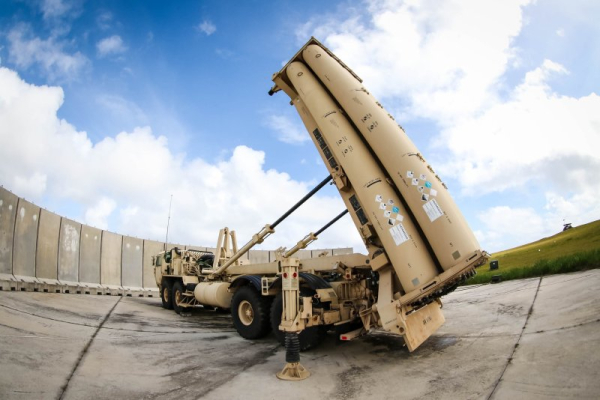
Components of a Terminal High Altitude Area Defense arrived in Israel on Monday, the Pentagon said. File Photo by Capt. Adan Cazarez/U.S. ARMY/UPI
Components of a ballistic missile air defense battery have arrived in Israel, the Pentagon announced Tuesday, just days after President Joe Biden instructed the U.S. military to deploy the Terminal High Altitude Area Defense system to the besieged ally.
The components arrived in Israel on Monday along with an advanced team of U.S. soldiers necessary to operate the defensive weaponry system, Pentagon press secretary Maj. Gen. Pat Ryder said in a statement. Advertisement
Additional soldiers and components are to arrive in Israel in the days ahead, and the THAAD system is expected to soon be fully operational, though Ryder would not specify when due to security concerns.
“The deployment of the THAAD battery to Israel underscores the United States’ commitment to the defense of Israel and to defend Americans in Israel from any ballistic missile attacks by Iran,” Ryder said.
Israel and Iran have long been engaged in a proxy war that exploded into the open on Oct. 7, 2023, when Tehran-backed militia Hamas in Gaza attacked Israel, killing 1,200 Israelis and kidnapping another 251. Advertisement
Embolden by the war, other Iran-proxy militias, in particular Hezbollah in Lebanon and the Houthis in Yemen, have also attacked Israel. Iran, notably on April 13 and Oct. 1, launched hundreds ballistic missiles and drones at the U.S. ally.
On Sunday, Defense Secretary Lloyd Austin announced that the United States would deploy a THAAD system to Israel “following Iran’s unprecedented attacks.”
The deployment is expected to include about 100 U.S. soldiers to operate the advanced system, marking the first time U.S. forces have been sent to Israel since the Israel-Hamas war began, though U.S. military personnel have been in the country throughout the conflict.
Deputy Pentagon press secretary Sabrina Singh told reporters during a press conference on Tuesday that the system is meant to augment Israel’s defenses and serves a similar function to the U.S. Navy destroyers downing projectiles that the Houthis have been launching at Israel from Yemen.
“They provide a ballistic missile defense capability that is sea-based — this one’s land based,” she said.
Singh also defended its deployment by highlighting the differences between Iran’s two direct attacks on Israel, by saying the number of ballistic missiles used on Oct. 1 was nearly double those fired by Iran on April 13. Advertisement
Cruise missiles and drones can be downed by fighter jets, which are not going to engage with ballistic missiles. That’s where the U.S. Navy Destroyers at sea and THAAD systems on land come in, she said.
“The THAAD serves a similar purpose to our DDGs,” she said. “It is an air defense system that is helping augment Israel’s air defenses that can help shoot down ballistic missiles.”
“This is also meant to be a temporary provision of air defense capabilities to better protect Israel.”
THAADs have been previously deployed to the region, once last year following Hamas’ attack and to Israel in 2019 for training purposes.
A THAAD system has also been deployed to South Korea since 2017.